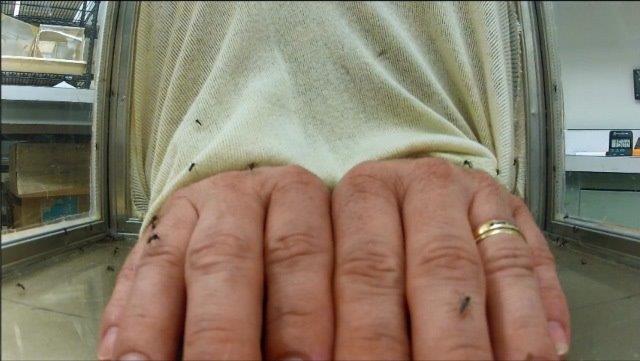EMBARGOED FOR RELEASE | September 09, 2013
Toward making people invisible to mosquitoes
Note to journalists: Please report that this research was presented at a meeting of the American Chemical Society.
A press conference on this topic will be held on Monday, Sept. 9, at 11:30 a.m. in the ACS Press Center, Room 211, in the Indiana Convention Center. Reporters can attend in person or access live audio and video of the event and ask questions at www.ustream.tv/channel/acslive.
INDIANAPOLIS, Sept. 9, 2013 — In an advance toward providing mosquito-plagued people, pets and livestock with an invisibility cloak against these blood-sucking insects, scientists today described discovery of substances that occur naturally on human skin and block mosquitoes’ ability to smell and target their victims.
The presentation was among almost 7,000 scheduled here this week at the 246th National Meeting & Exposition of the American Chemical Society, the world’s largest scientific society. Thousands of scientists and others are expected to attend the sessions, being held in the Indiana Convention Center and downtown hotels.
Ulrich Bernier, Ph.D., who gave the talk, cited the pressing need for better ways to combat mosquitoes. Far from being just a nuisance, mosquitoes are more deadly to humans than any other animal. Their bites transmit malaria and other diseases that kill an estimated 1 million people around the world each year. In the United States, mosquitoes spread rare types of encephalitis, an inflammation of the brain. They also transmit heartworms to pet dogs and cats.
“Repellents have been the mainstay for preventing mosquito bites,” said Bernier. “The most widely used repellant, DEET, is quite effective and has been in use for a long time. However, some people don’t like the feel or the smell of DEET. We are exploring a different approach, with substances that impair the mosquito’s sense of smell. If a mosquito can’t sense that dinner is ready, there will be no buzzing, no landing and no bite.”
Female mosquitoes, which suck blood to obtain a protein needed to produce fertile eggs, can smell people from over 100 feet away. The Mosquito and Fly Unit at the U.S. Department of Agriculture’s Agricultural Research Service-Center for Medical, Agricultural, and Veterinary Entomology in Gainesville, Fla., has been doing research on mosquito repellents since the 1940s. In the 1990s, they accumulated information on substances secreted through the human skin or formed by bacteria on the skin that make some people more attractive to mosquitoes than others.
A person’s scent, Bernier explained, comes from hundreds of compounds on the skin, many emitted through sweat and others produced by bacteria. To identify which of these attract mosquitoes, Bernier and colleagues used a special mosquito cage divided by a screen. They sprayed various substances into one side of the cage, and documented the effects in attracting mosquitoes. Some compounds, like lactic acid — a common component of human sweat — were definite mosquito lures, drawing 90 percent of the mosquitoes to the screen. With other compounds, however, many of the mosquitoes didn’t even take flight or seemed confused.
“If you put your hand in a cage of mosquitoes where we have released some of these inhibitors, almost all just sit on the back wall and don’t even recognize that the hand is in there. We call that anosmia or hyposmia, the inability to sense smells or a reduced ability to sense smells,” explained Bernier.
He said that a group of chemical compounds, including 1-methylpiperzine, block mosquitoes’ sense of smell. This may help explain why mosquitoes fly toward some people but not others. The substances have a molecular architecture found in ingredients in dozens of medicines and other products. They appear suitable for use in cosmetics, lotions, clothing and other products that currently incorporate mosquito repellants.
Bernier’s team cited funding from the U.S. Departments of Agriculture and Defense.
His presentation was part of a meeting symposium on biopesticides, which come from natural sources such as plants, animals, minerals and bacteria.
To automatically receive news releases from the American Chemical Society, contact newsroom@acs.org.
# # #
The American Chemical Society is a nonprofit organization chartered by the U.S. Congress. With more than 163,000 members, ACS is the world's largest scientific society and a global leader in providing access to chemistry-related research through its multiple databases, peer-reviewed journals and scientific conferences. Its main offices are in Washington, D.C., and Columbus, Ohio.
Media Contact
During the national meeting, Sept. 6-11, the contacts can be reached at 317-262-5907.
Michael Bernstein
m_bernstein@acs.org
202-872-6042
Michael Woods
m_woods@acs.org
202-872-6293
High-resolution image






